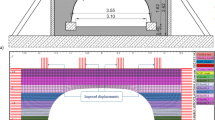Abstract
The construction of braced excavations in urban areas requires control of surrounding ground movements since excessive ground movements damage adjacent properties. Design of this type construction involves proper estimation of soil parameters. Prediction of these soil parameters may be done by controlled laboratory tests simulating actual field conditions. Laboratory tests carried out with small size samples sometimes do not replicate the field situations comprising variations in soil properties with depth specially for stratified soils. So, field data are largely being used for estimation of various soil parameters related to analysis and design of braced excavations. Precise prediction of parameters is possible if inverse method is used as the identified parameters are representative of macroscopic soil mass as a whole. The present paper works out back-analysis of soil stiffness parameters on the basis of three reported case studies. Here the braced wall has been considered as a continuous beam with soil from backfill side is acting as load and strut as well as soil from cut side act as support. Optimization (both constrained and unconstrained) technique is used for predicting values of coefficients of soil subgrade modulus. The predicted deflections are found to be quite close to the measured values which support the proposed method of parameter estimation.










Similar content being viewed by others
Abbreviations
- E:
-
Modulus of elasticity of wall member
- I:
-
Moment of inertia of wall
- Mi :
-
Moment at any point ‘i’ on the wall
- Ri :
-
Reaction forces from soil to the wall at point ‘i’
- P:
-
Strut force
- Ki :
-
Modulus of subgrade reaction of soil at any point ‘i’
- yi :
-
Deflection of wall at point ‘i’
- h:
-
Distance between two successive flexible support
- A:
-
Initial modulus of subgrade reaction
- B:
-
Increase of modulus of subgrade reaction with depth
- α:
-
Exponent to fit K value
- F:
-
Objective function value
- R:
-
Reaction force calculated from measured wall deflection
- Rpred :
-
Predicted reaction force including term of modulus of subgrade reaction
- P:
-
Penalty function for optimization
- r:
-
Set of penalty parameters
- Ω:
-
Penalty term to choose the feasible points
- g:
-
Constraint used in bracket operator penalty function
References
Asaoka A, Matsuo M (1979) Bayesian approach to inverse problem in consolidation and its application to settlement prediction. In: Proceedings of third international conference on numerical methods and geomechanics, Aachen, pp 115–123
Yamagami T, Ueta Y (1987) Optimization techniques for back analysis of failed slopes. In: Proceedings of the 8th Asian regional conference, Kyoto, vol 1, pp 513–516
Bergado DT, Enriques AS, Sampaco CL, Alfaro MC, Balasubramaniam AS (1992) Inverse analysis of geotechnical parameters on improved soft Bangkok clay. J Geotech Eng ASCE 118(7):1012–1030
Bhattacharya G, Basudhar PK (1996) A note on the back analysis of slope failures. Indian Geotech J 26(4):430–441
Honjo Y, Iwamoto S, Sugimoto M, Onimaru S, Yoshzawa M (1998) Inverse analysis of dynamic soil properties based on seismometer array records using the extended Bayesian method. Soils Found 38(1):131–143
Das SK, Basudhar PK (2005) Parameter estimation of Hoek–Brown rock failure criterion. Indian Geotech J 35(2):144–153
Das SK, Basudhar PK (2006) Comparison study of parameter estimation techniques for rock failure criterion models. Can Geotech J 43(7):764–771
Finno RJ, Rechea C (2006) Use of lateral movements and strut loads in inverse analysis of supported excavations. In: GeoCongress 2006: Geotechnical Engineering in the Information Technology Age, ASCE, Atlanta, pp 1–6.3
Caudron SE, Dias D, Kastner R (2007) Assessment of soil parameters met during a Tunnel Excavation. Use of Inverse analysis on in situ measurements. Case of Boris De Peu. In: Geo-Denver 2007, GSP 173: advances in measurement and modeling of soil behaviour. ASCE, Denver, pp 1–10
Olson SM, Johnson CI (2008) Analyzing liquefaction-induced lateral spreads using strength ratios. J Geotech Geoenviron Eng ASCE 134(8):1035–1049
Peck RB (1969) “Deep excavation and tunnelling”-state of the art report. In: Proceedings of 7th ICSMFE, Mexico, vol 3.5
Bowles JE (1984) Foundation analysis and design, 2nd edn. McGraw-Hill, Tokyo
Terzaghi K (1955) Evaluation of coefficients of sub-grade reaction. Geotechnique 5:297–326
IS 2911 Part II (2010) Design and construction of pile foundations. Bureau of Indian Standards, BIS 2010, pp 14–15
Som NN (1991) Performance study of braced cuts for Calcutta Metro Construction. In: Proceedings of 9th Asian regional conference on SMFE, Bangkok, vol 2, pp 387–394
Clough GW, Reed MW (1984) Measured behavior of braced wall in very soft clay. J Geotech Eng 110(1):1–19
Thasnanipan N, Maung AW, Tanseng P, Wei SH (1998) Performance of a braced excavation in Bangkok Clay. Diaphragm wall subject to unbalanced loading conditions. In: Thirteenth Southeast Asian geotechnical conference, Taipei, pp 655–660
Author information
Authors and Affiliations
Corresponding author
Rights and permissions
About this article
Cite this article
Dan, K., Sahu, R.B. An Inverse Analysis for Parameter Estimation of Braced Excavation in Soft Clay Using Non-Linear Programming. Indian Geotech J 45, 291–303 (2015). https://doi.org/10.1007/s40098-014-0132-4
Received:
Accepted:
Published:
Issue Date:
DOI: https://doi.org/10.1007/s40098-014-0132-4




